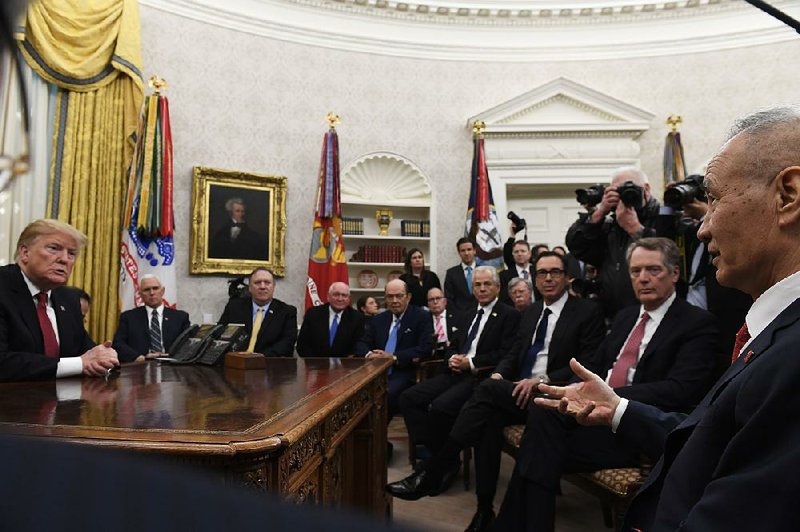WASHINGTON -- President Donald Trump said Thursday that he would meet Chinese President Xi Jinping this month in hopes of finalizing a trade deal, even as a leading business group warned that China had offered nothing new to resolve several major stumbling blocks during two days of talks this week.
Trump is dispatching top trade negotiators to China after this week's talks in Washington.
Treasury Secretary Steven Mnuchin and U.S. Trade Representative Robert Lighthizer will travel as the team has continuous negotiations with China, the pair told reporters in the Oval Office on Thursday after Trump met with Chinese Vice Premier Liu He.
Trump's decision to seize personal control of the negotiations raised the already high stakes in efforts to defuse conflict between the world's two largest economies. Negotiators, who have yet even to prepare a draft agreement, must in the next 30 days settle issues that have bedeviled U.S. and Chinese diplomats for years in order to leave the two presidents with a manageable to-do list for their head-to-head bargaining.
At the White House, the president suggested that the talks might blow past his March deadline, and he cast doubt on the extent of an eventual agreement. "I think we can do it by March 1st. Can you get it down on paper by March 1st? I don't know. I can tell you on March 1st the tariff on China goes to 25 percent," he told reporters.
Technically, the tariff on $200 billion in imports from China increases at 12:01 a.m. on March 2.
"This is going to be a very big deal, or it's going to be a deal that we'll just postpone for a little."
After insisting for the past year that they would not settle for the sort of half measures that previous U.S. administrations had accepted, Trump administration officials now risk precisely that outcome: a partial deal that avoids grappling with the thorniest elements in the Chinese state-led economic model.
The two sides made headway this week on opening Chinese markets and securing greater intellectual property protections for foreign companies, according to Myron Brilliant, executive vice president and head of international affairs for the U.S. Chamber of Commerce, who had spoken to members of the U.S. delegation.
But the Chinese team offered nothing to break the deadlock over major elements of China's economic model, including state subsidies, state-owned enterprises and forced technology transfers, he said.
Negotiators this week were not expected to produce a "framework agreement or negotiating document," which must be fleshed out before Trump sits down with Xi, Brilliant said.
"I don't think we're getting very far, not yet in these negotiations. ... We're going to have to see more progress made," he said.
The White House announced early last month that Trump plans to meet late this month with North Korean leader Kim Jong Un. Vietnam has been discussed as a potential venue, so adding a stop to bargain with Xi might work, some analysts said.
"It can't be settled below that level," William Reinsch, a former Commerce Department official, said of the U.S.-China trade spat.
Trade analysts said a potential meeting between Trump and Xi was a strong sign that an agreement could be within reach, as Trump has shown a greater inclination to close a deal than hawkish top trade negotiator Lighthizer.
Even as the president signaled a willingness to take personal control of the negotiations, a leading American business group insisted that additional progress is needed before the two leaders should meet.
Dennis Wilder, a former top China analyst for the CIA, said the Chinese are betting that they can secure a better deal in direct leader-to-leader horse-trading.
For the U.S., presidential involvement is needed to break the "bureaucratic logjam" between hardliners such as Lighthizer and Trump advisers who fear the trade war's impact on the U.S. economy and financial markets, he said.
"Trump is the kind of guy who's never going to accept that the deal is good enough unless he's in the room cutting the deal," Wilder said, calling a summit "the inevitable conclusion" of the trade conflict.
Wilder, who directed East Asian affairs for the National Security Council under President George W. Bush, suggested that the two leaders could huddle on Hainan Island, off the southern Chinese coast.
The president is seeking structural changes in China's state-led economic model, as well as an increase in the annual value of American goods purchased by Chinese customers.
China has offered to accelerate orders for products such as American soybeans and liquefied natural gas but is resisting demands to overhaul its industrial policies.
A deal for additional Chinese purchases of American goods can be completed quickly. But some analysts say that securing an agreement addressing U.S. complaints about China's alleged theft of trade secrets, forced technology transfer requirements for joint ventures and discrimination against foreign companies is difficult to imagine in the short time remaining.
Information for this article was contributed by Saleha Mohsin and Jennifer Jacobs of Bloomberg News; and by Alan Rappeport of The New York Times.
Business on 02/01/2019

